Defects Reduction of Plastic Injection Molding
VerifiedAdded on 2023/06/08
|18
|2346
|426
AI Summary
This research paper focuses on reducing the rate of rejection by the customer to 100 defected parts per million (DPPM) in plastic injection molding. It examines how to accurately monitor defects during production, analyzes the most severe complaints raised by customers, and implements real solutions to achieve defect-free items. The study uses seven basic quality tools to analyze defects found in the in progress quality control (IPQC) and outgoing quality control (OQC) departments. The subject is process improvement on the manufacturing shop floor.
Contribute Materials
Your contribution can guide someone’s learning journey. Share your
documents today.
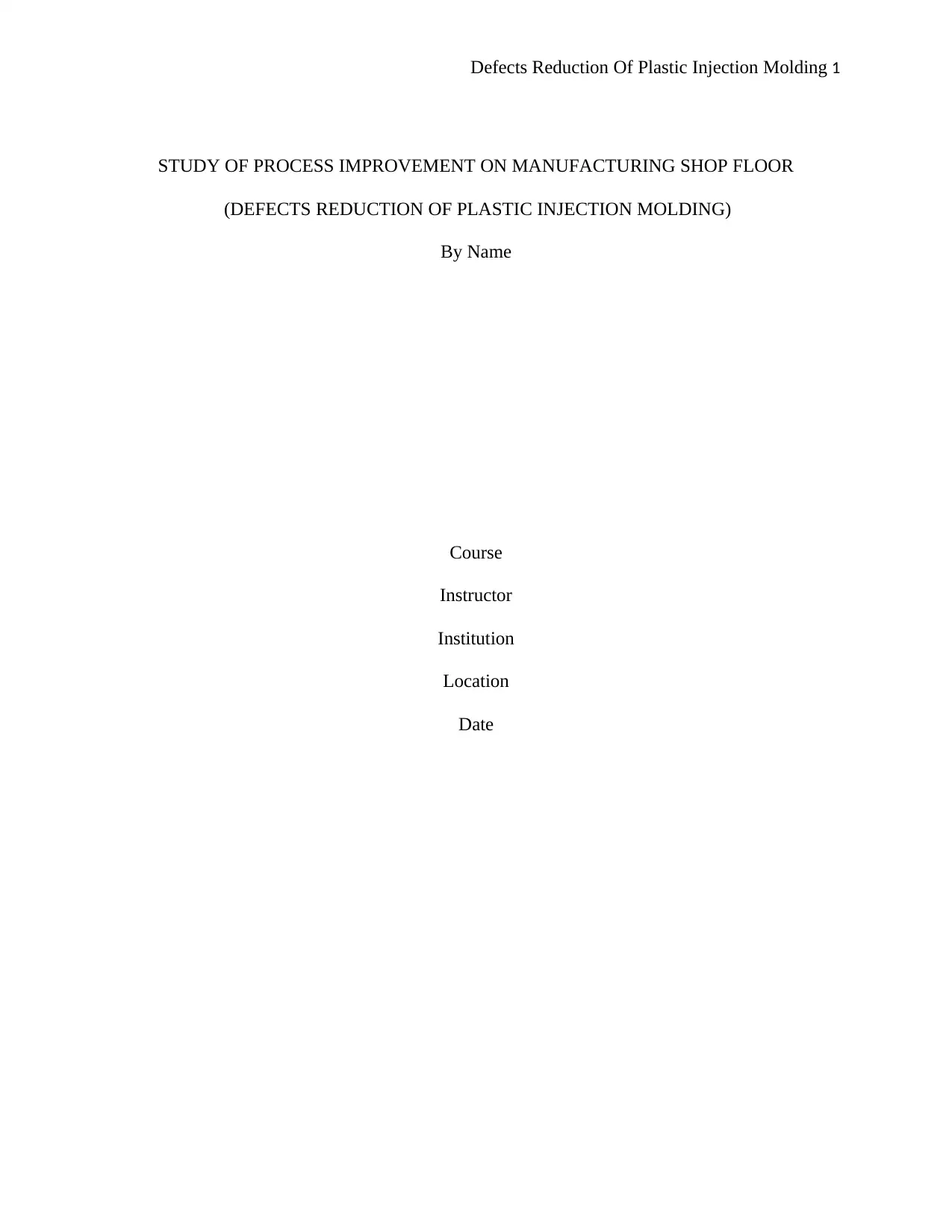
Defects Reduction Of Plastic Injection Molding 1
STUDY OF PROCESS IMPROVEMENT ON MANUFACTURING SHOP FLOOR
(DEFECTS REDUCTION OF PLASTIC INJECTION MOLDING)
By Name
Course
Instructor
Institution
Location
Date
STUDY OF PROCESS IMPROVEMENT ON MANUFACTURING SHOP FLOOR
(DEFECTS REDUCTION OF PLASTIC INJECTION MOLDING)
By Name
Course
Instructor
Institution
Location
Date
Secure Best Marks with AI Grader
Need help grading? Try our AI Grader for instant feedback on your assignments.
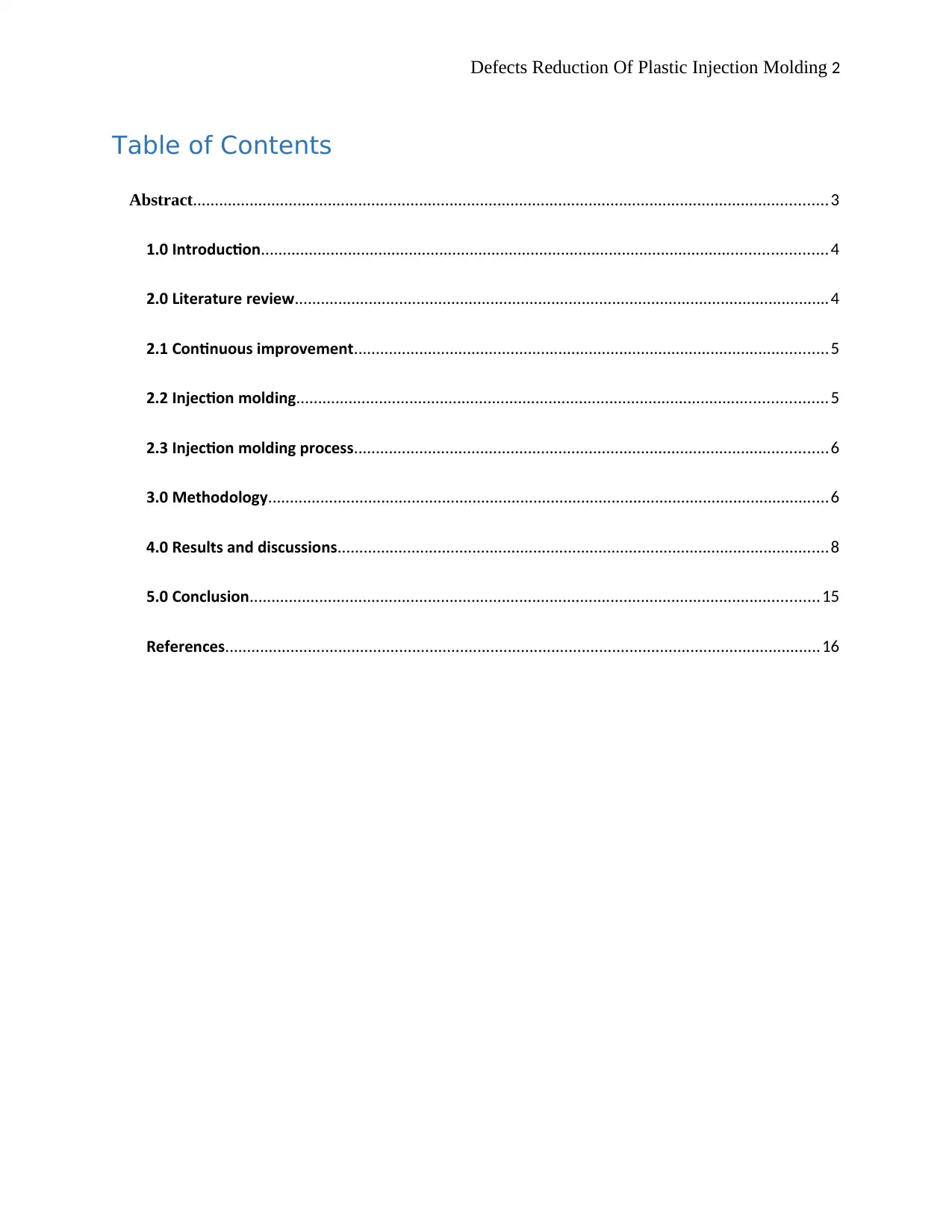
Defects Reduction Of Plastic Injection Molding 2
Table of Contents
Abstract..................................................................................................................................................3
1.0 Introduction..................................................................................................................................4
2.0 Literature review...........................................................................................................................4
2.1 Continuous improvement.............................................................................................................5
2.2 Injection molding..........................................................................................................................5
2.3 Injection molding process.............................................................................................................6
3.0 Methodology.................................................................................................................................6
4.0 Results and discussions.................................................................................................................8
5.0 Conclusion...................................................................................................................................15
References.........................................................................................................................................16
Table of Contents
Abstract..................................................................................................................................................3
1.0 Introduction..................................................................................................................................4
2.0 Literature review...........................................................................................................................4
2.1 Continuous improvement.............................................................................................................5
2.2 Injection molding..........................................................................................................................5
2.3 Injection molding process.............................................................................................................6
3.0 Methodology.................................................................................................................................6
4.0 Results and discussions.................................................................................................................8
5.0 Conclusion...................................................................................................................................15
References.........................................................................................................................................16
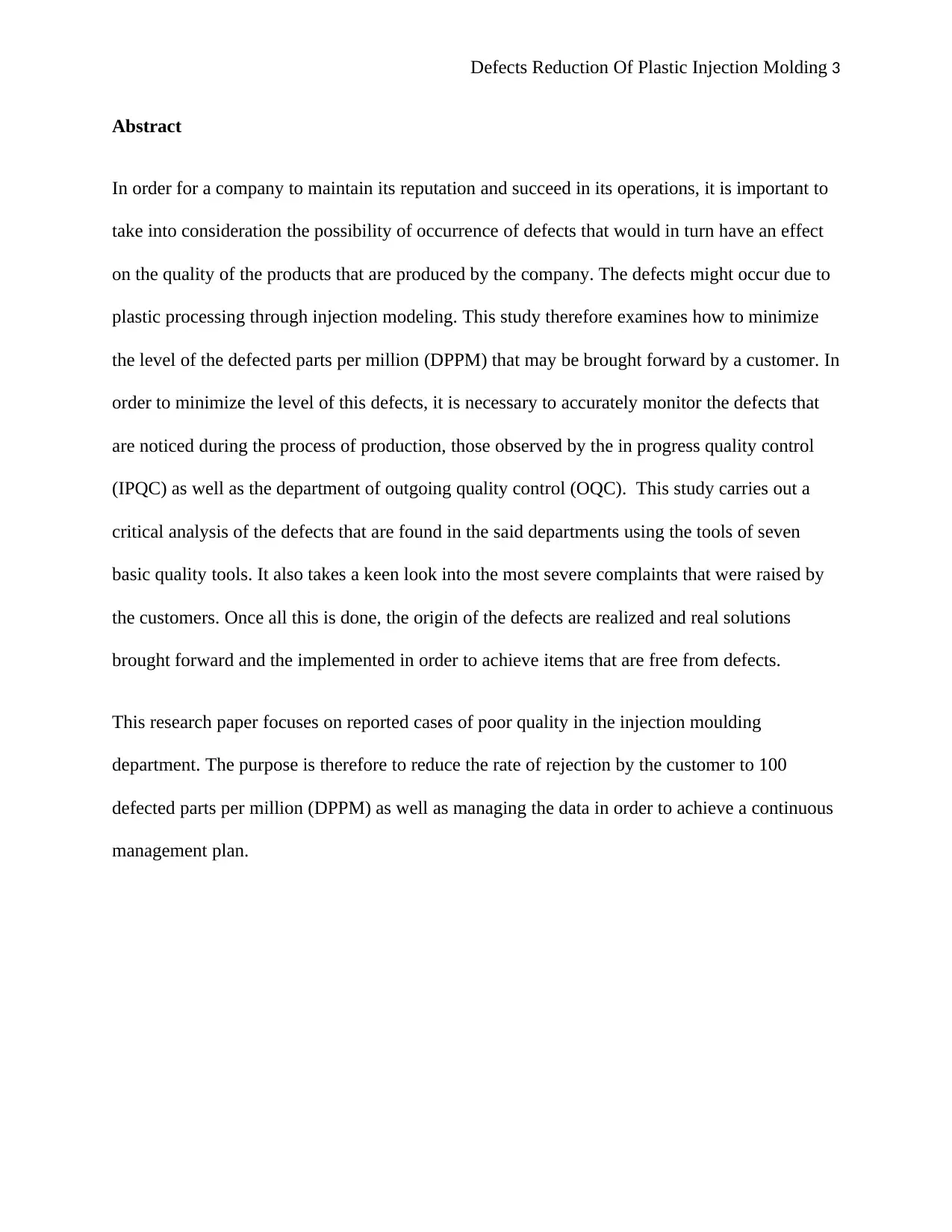
Defects Reduction Of Plastic Injection Molding 3
Abstract
In order for a company to maintain its reputation and succeed in its operations, it is important to
take into consideration the possibility of occurrence of defects that would in turn have an effect
on the quality of the products that are produced by the company. The defects might occur due to
plastic processing through injection modeling. This study therefore examines how to minimize
the level of the defected parts per million (DPPM) that may be brought forward by a customer. In
order to minimize the level of this defects, it is necessary to accurately monitor the defects that
are noticed during the process of production, those observed by the in progress quality control
(IPQC) as well as the department of outgoing quality control (OQC). This study carries out a
critical analysis of the defects that are found in the said departments using the tools of seven
basic quality tools. It also takes a keen look into the most severe complaints that were raised by
the customers. Once all this is done, the origin of the defects are realized and real solutions
brought forward and the implemented in order to achieve items that are free from defects.
This research paper focuses on reported cases of poor quality in the injection moulding
department. The purpose is therefore to reduce the rate of rejection by the customer to 100
defected parts per million (DPPM) as well as managing the data in order to achieve a continuous
management plan.
Abstract
In order for a company to maintain its reputation and succeed in its operations, it is important to
take into consideration the possibility of occurrence of defects that would in turn have an effect
on the quality of the products that are produced by the company. The defects might occur due to
plastic processing through injection modeling. This study therefore examines how to minimize
the level of the defected parts per million (DPPM) that may be brought forward by a customer. In
order to minimize the level of this defects, it is necessary to accurately monitor the defects that
are noticed during the process of production, those observed by the in progress quality control
(IPQC) as well as the department of outgoing quality control (OQC). This study carries out a
critical analysis of the defects that are found in the said departments using the tools of seven
basic quality tools. It also takes a keen look into the most severe complaints that were raised by
the customers. Once all this is done, the origin of the defects are realized and real solutions
brought forward and the implemented in order to achieve items that are free from defects.
This research paper focuses on reported cases of poor quality in the injection moulding
department. The purpose is therefore to reduce the rate of rejection by the customer to 100
defected parts per million (DPPM) as well as managing the data in order to achieve a continuous
management plan.
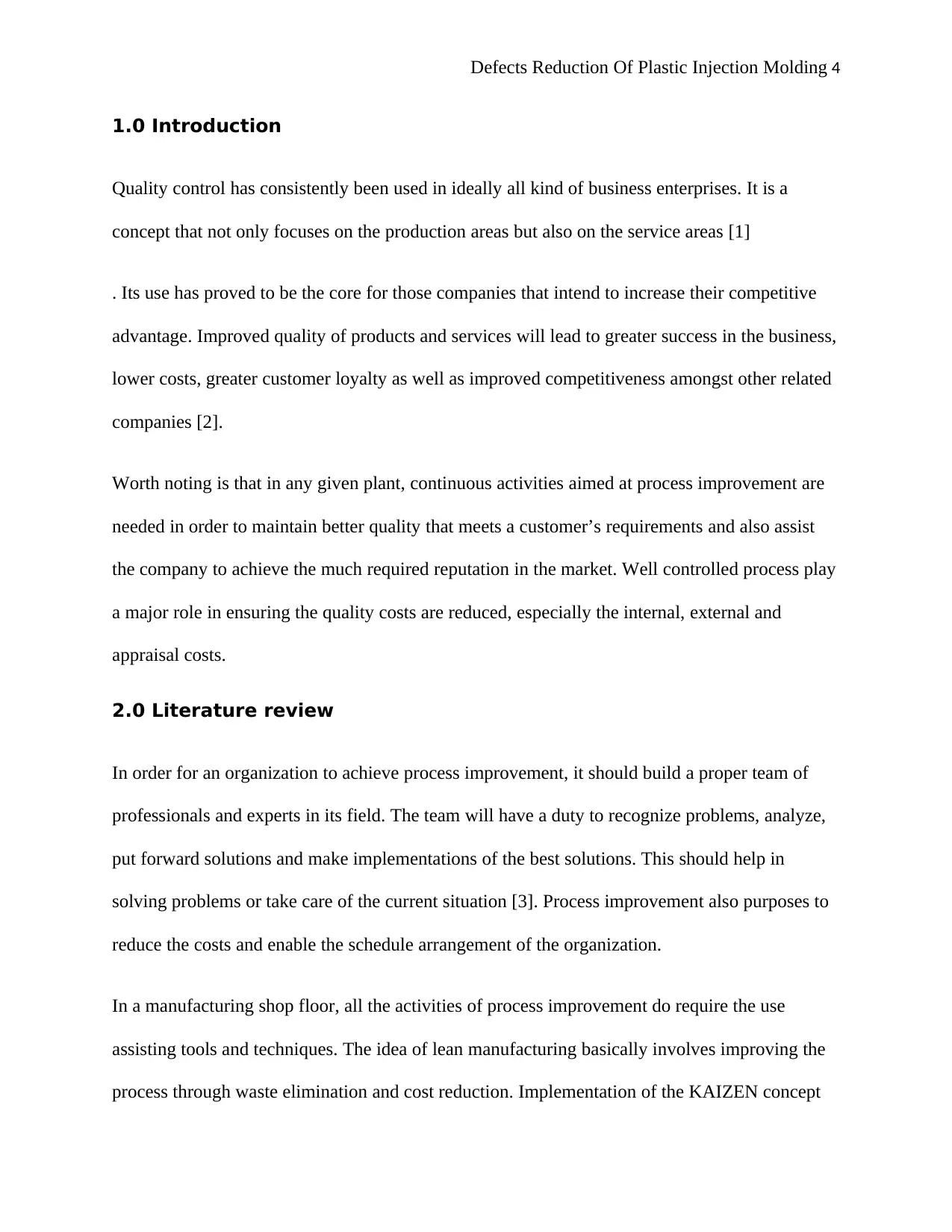
Defects Reduction Of Plastic Injection Molding 4
1.0 Introduction
Quality control has consistently been used in ideally all kind of business enterprises. It is a
concept that not only focuses on the production areas but also on the service areas [1]
. Its use has proved to be the core for those companies that intend to increase their competitive
advantage. Improved quality of products and services will lead to greater success in the business,
lower costs, greater customer loyalty as well as improved competitiveness amongst other related
companies [2].
Worth noting is that in any given plant, continuous activities aimed at process improvement are
needed in order to maintain better quality that meets a customer’s requirements and also assist
the company to achieve the much required reputation in the market. Well controlled process play
a major role in ensuring the quality costs are reduced, especially the internal, external and
appraisal costs.
2.0 Literature review
In order for an organization to achieve process improvement, it should build a proper team of
professionals and experts in its field. The team will have a duty to recognize problems, analyze,
put forward solutions and make implementations of the best solutions. This should help in
solving problems or take care of the current situation [3]. Process improvement also purposes to
reduce the costs and enable the schedule arrangement of the organization.
In a manufacturing shop floor, all the activities of process improvement do require the use
assisting tools and techniques. The idea of lean manufacturing basically involves improving the
process through waste elimination and cost reduction. Implementation of the KAIZEN concept
1.0 Introduction
Quality control has consistently been used in ideally all kind of business enterprises. It is a
concept that not only focuses on the production areas but also on the service areas [1]
. Its use has proved to be the core for those companies that intend to increase their competitive
advantage. Improved quality of products and services will lead to greater success in the business,
lower costs, greater customer loyalty as well as improved competitiveness amongst other related
companies [2].
Worth noting is that in any given plant, continuous activities aimed at process improvement are
needed in order to maintain better quality that meets a customer’s requirements and also assist
the company to achieve the much required reputation in the market. Well controlled process play
a major role in ensuring the quality costs are reduced, especially the internal, external and
appraisal costs.
2.0 Literature review
In order for an organization to achieve process improvement, it should build a proper team of
professionals and experts in its field. The team will have a duty to recognize problems, analyze,
put forward solutions and make implementations of the best solutions. This should help in
solving problems or take care of the current situation [3]. Process improvement also purposes to
reduce the costs and enable the schedule arrangement of the organization.
In a manufacturing shop floor, all the activities of process improvement do require the use
assisting tools and techniques. The idea of lean manufacturing basically involves improving the
process through waste elimination and cost reduction. Implementation of the KAIZEN concept
Secure Best Marks with AI Grader
Need help grading? Try our AI Grader for instant feedback on your assignments.
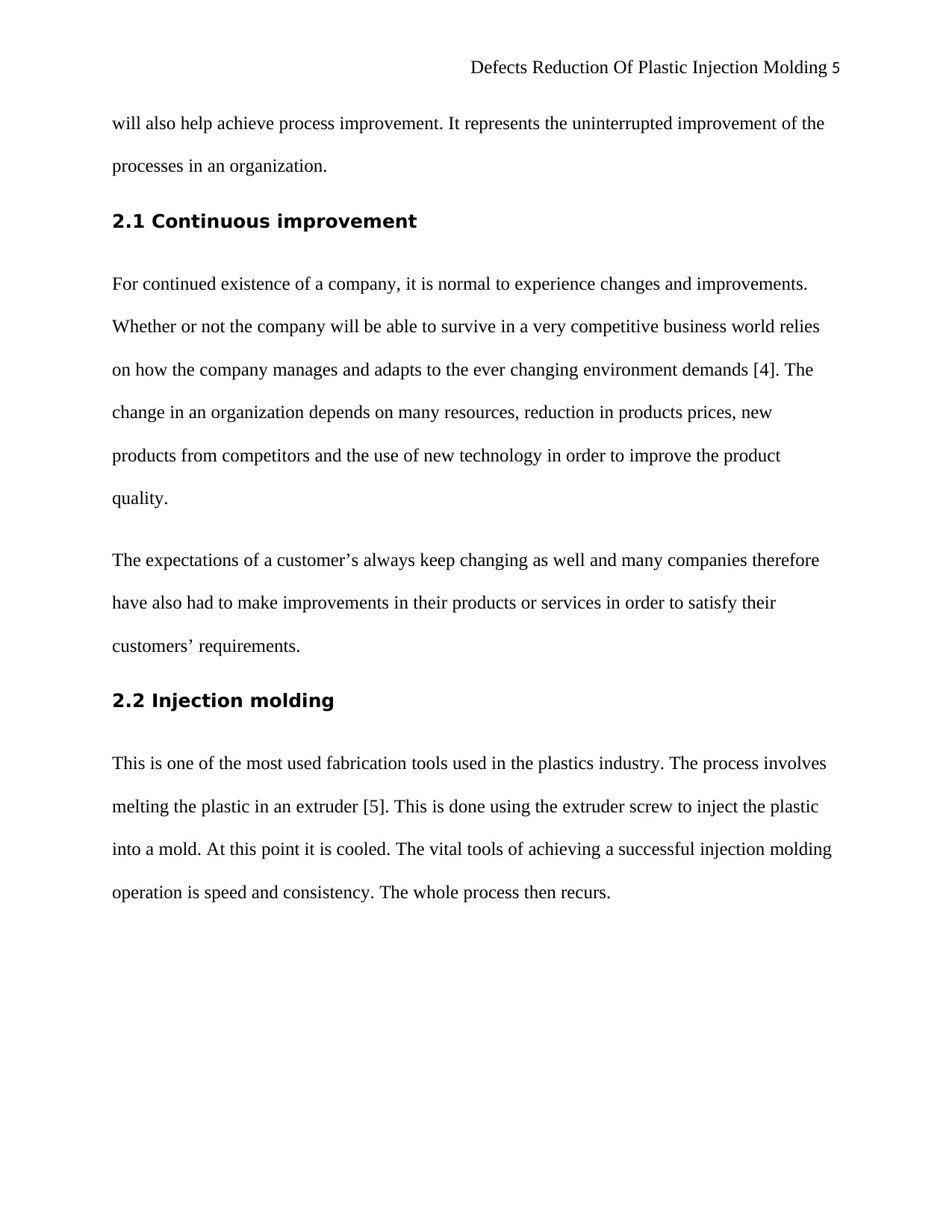
Defects Reduction Of Plastic Injection Molding 5
will also help achieve process improvement. It represents the uninterrupted improvement of the
processes in an organization.
2.1 Continuous improvement
For continued existence of a company, it is normal to experience changes and improvements.
Whether or not the company will be able to survive in a very competitive business world relies
on how the company manages and adapts to the ever changing environment demands [4]. The
change in an organization depends on many resources, reduction in products prices, new
products from competitors and the use of new technology in order to improve the product
quality.
The expectations of a customer’s always keep changing as well and many companies therefore
have also had to make improvements in their products or services in order to satisfy their
customers’ requirements.
2.2 Injection molding
This is one of the most used fabrication tools used in the plastics industry. The process involves
melting the plastic in an extruder [5]. This is done using the extruder screw to inject the plastic
into a mold. At this point it is cooled. The vital tools of achieving a successful injection molding
operation is speed and consistency. The whole process then recurs.
will also help achieve process improvement. It represents the uninterrupted improvement of the
processes in an organization.
2.1 Continuous improvement
For continued existence of a company, it is normal to experience changes and improvements.
Whether or not the company will be able to survive in a very competitive business world relies
on how the company manages and adapts to the ever changing environment demands [4]. The
change in an organization depends on many resources, reduction in products prices, new
products from competitors and the use of new technology in order to improve the product
quality.
The expectations of a customer’s always keep changing as well and many companies therefore
have also had to make improvements in their products or services in order to satisfy their
customers’ requirements.
2.2 Injection molding
This is one of the most used fabrication tools used in the plastics industry. The process involves
melting the plastic in an extruder [5]. This is done using the extruder screw to inject the plastic
into a mold. At this point it is cooled. The vital tools of achieving a successful injection molding
operation is speed and consistency. The whole process then recurs.
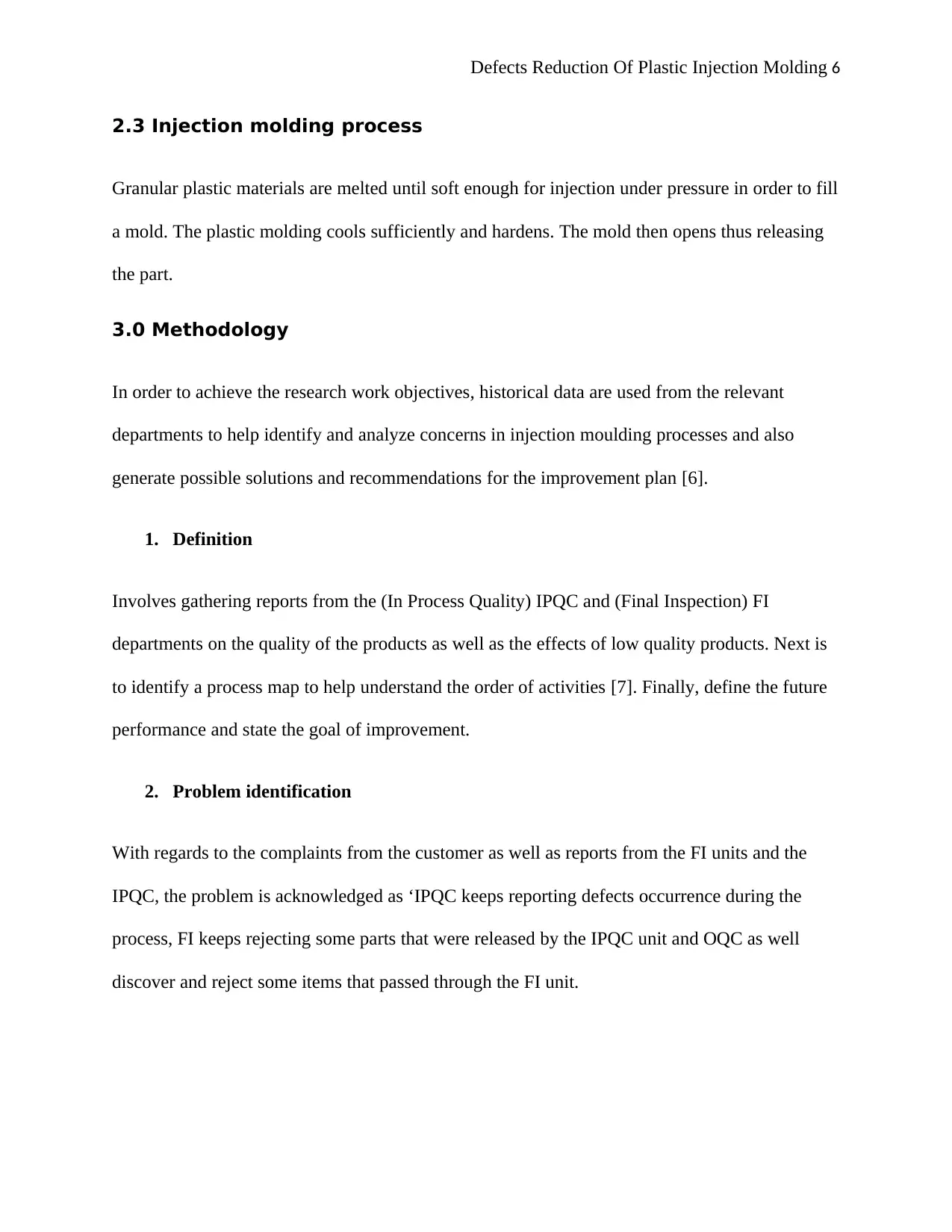
Defects Reduction Of Plastic Injection Molding 6
2.3 Injection molding process
Granular plastic materials are melted until soft enough for injection under pressure in order to fill
a mold. The plastic molding cools sufficiently and hardens. The mold then opens thus releasing
the part.
3.0 Methodology
In order to achieve the research work objectives, historical data are used from the relevant
departments to help identify and analyze concerns in injection moulding processes and also
generate possible solutions and recommendations for the improvement plan [6].
1. Definition
Involves gathering reports from the (In Process Quality) IPQC and (Final Inspection) FI
departments on the quality of the products as well as the effects of low quality products. Next is
to identify a process map to help understand the order of activities [7]. Finally, define the future
performance and state the goal of improvement.
2. Problem identification
With regards to the complaints from the customer as well as reports from the FI units and the
IPQC, the problem is acknowledged as ‘IPQC keeps reporting defects occurrence during the
process, FI keeps rejecting some parts that were released by the IPQC unit and OQC as well
discover and reject some items that passed through the FI unit.
2.3 Injection molding process
Granular plastic materials are melted until soft enough for injection under pressure in order to fill
a mold. The plastic molding cools sufficiently and hardens. The mold then opens thus releasing
the part.
3.0 Methodology
In order to achieve the research work objectives, historical data are used from the relevant
departments to help identify and analyze concerns in injection moulding processes and also
generate possible solutions and recommendations for the improvement plan [6].
1. Definition
Involves gathering reports from the (In Process Quality) IPQC and (Final Inspection) FI
departments on the quality of the products as well as the effects of low quality products. Next is
to identify a process map to help understand the order of activities [7]. Finally, define the future
performance and state the goal of improvement.
2. Problem identification
With regards to the complaints from the customer as well as reports from the FI units and the
IPQC, the problem is acknowledged as ‘IPQC keeps reporting defects occurrence during the
process, FI keeps rejecting some parts that were released by the IPQC unit and OQC as well
discover and reject some items that passed through the FI unit.
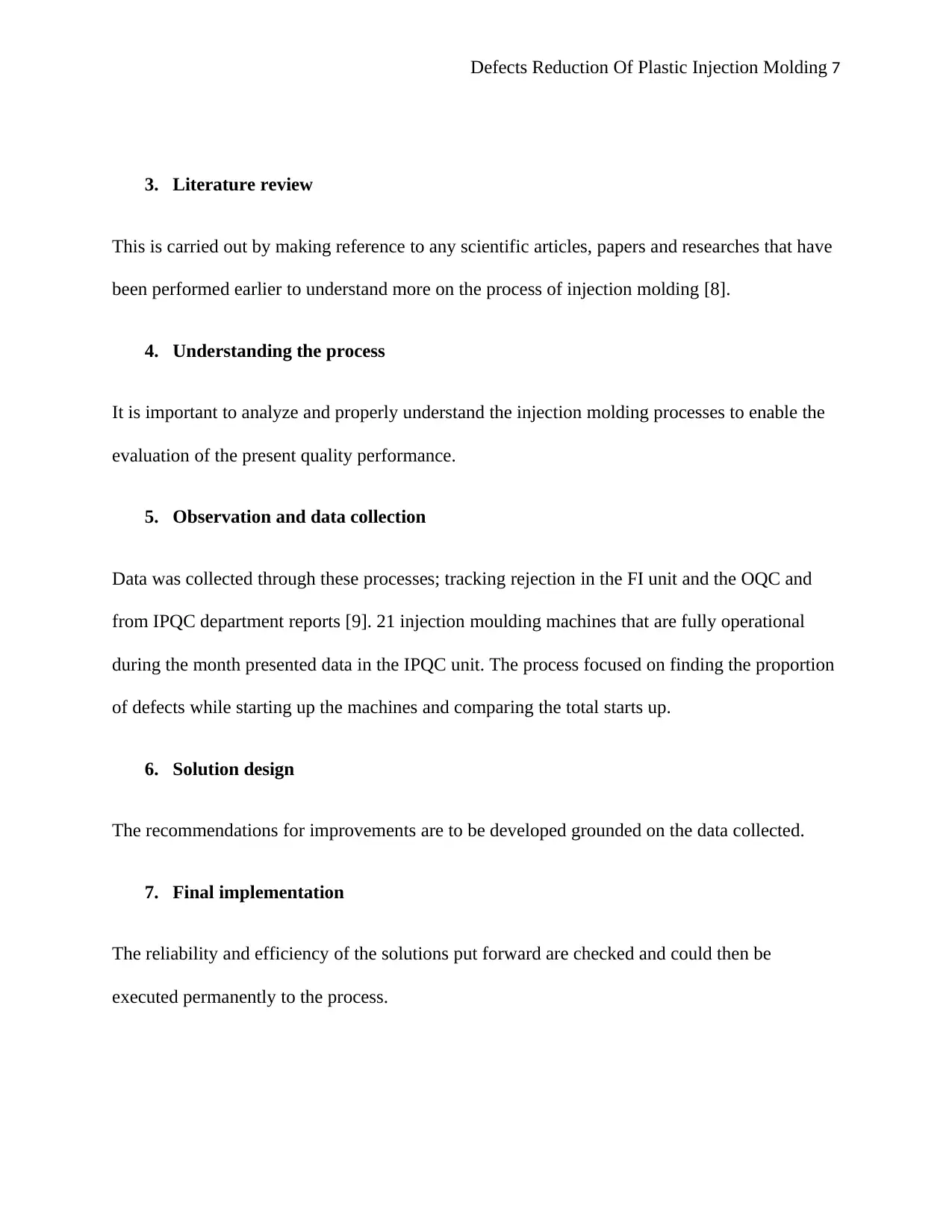
Defects Reduction Of Plastic Injection Molding 7
3. Literature review
This is carried out by making reference to any scientific articles, papers and researches that have
been performed earlier to understand more on the process of injection molding [8].
4. Understanding the process
It is important to analyze and properly understand the injection molding processes to enable the
evaluation of the present quality performance.
5. Observation and data collection
Data was collected through these processes; tracking rejection in the FI unit and the OQC and
from IPQC department reports [9]. 21 injection moulding machines that are fully operational
during the month presented data in the IPQC unit. The process focused on finding the proportion
of defects while starting up the machines and comparing the total starts up.
6. Solution design
The recommendations for improvements are to be developed grounded on the data collected.
7. Final implementation
The reliability and efficiency of the solutions put forward are checked and could then be
executed permanently to the process.
3. Literature review
This is carried out by making reference to any scientific articles, papers and researches that have
been performed earlier to understand more on the process of injection molding [8].
4. Understanding the process
It is important to analyze and properly understand the injection molding processes to enable the
evaluation of the present quality performance.
5. Observation and data collection
Data was collected through these processes; tracking rejection in the FI unit and the OQC and
from IPQC department reports [9]. 21 injection moulding machines that are fully operational
during the month presented data in the IPQC unit. The process focused on finding the proportion
of defects while starting up the machines and comparing the total starts up.
6. Solution design
The recommendations for improvements are to be developed grounded on the data collected.
7. Final implementation
The reliability and efficiency of the solutions put forward are checked and could then be
executed permanently to the process.
Paraphrase This Document
Need a fresh take? Get an instant paraphrase of this document with our AI Paraphraser

Defects Reduction Of Plastic Injection Molding 8
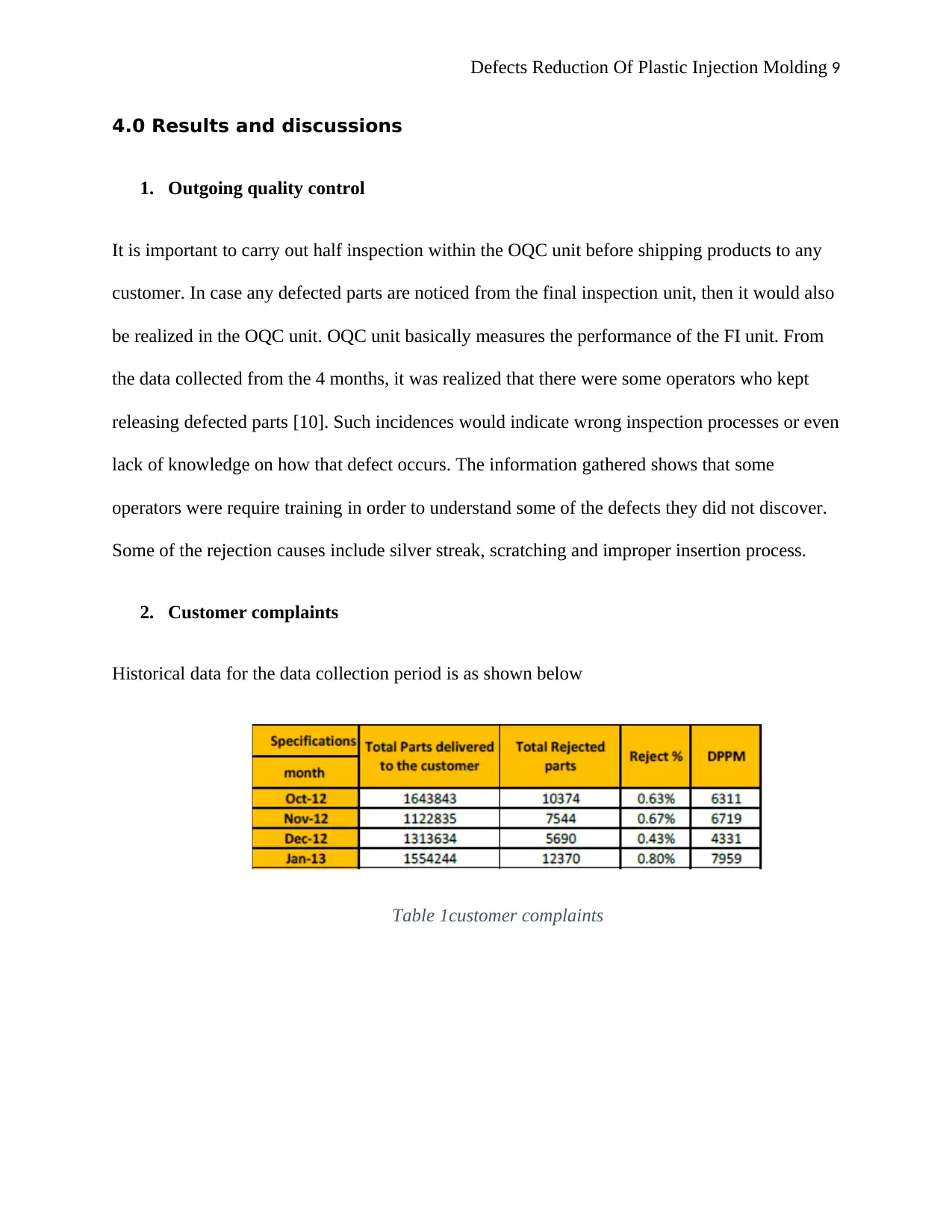
Defects Reduction Of Plastic Injection Molding 9
4.0 Results and discussions
1. Outgoing quality control
It is important to carry out half inspection within the OQC unit before shipping products to any
customer. In case any defected parts are noticed from the final inspection unit, then it would also
be realized in the OQC unit. OQC unit basically measures the performance of the FI unit. From
the data collected from the 4 months, it was realized that there were some operators who kept
releasing defected parts [10]. Such incidences would indicate wrong inspection processes or even
lack of knowledge on how that defect occurs. The information gathered shows that some
operators were require training in order to understand some of the defects they did not discover.
Some of the rejection causes include silver streak, scratching and improper insertion process.
2. Customer complaints
Historical data for the data collection period is as shown below
Table 1customer complaints
4.0 Results and discussions
1. Outgoing quality control
It is important to carry out half inspection within the OQC unit before shipping products to any
customer. In case any defected parts are noticed from the final inspection unit, then it would also
be realized in the OQC unit. OQC unit basically measures the performance of the FI unit. From
the data collected from the 4 months, it was realized that there were some operators who kept
releasing defected parts [10]. Such incidences would indicate wrong inspection processes or even
lack of knowledge on how that defect occurs. The information gathered shows that some
operators were require training in order to understand some of the defects they did not discover.
Some of the rejection causes include silver streak, scratching and improper insertion process.
2. Customer complaints
Historical data for the data collection period is as shown below
Table 1customer complaints
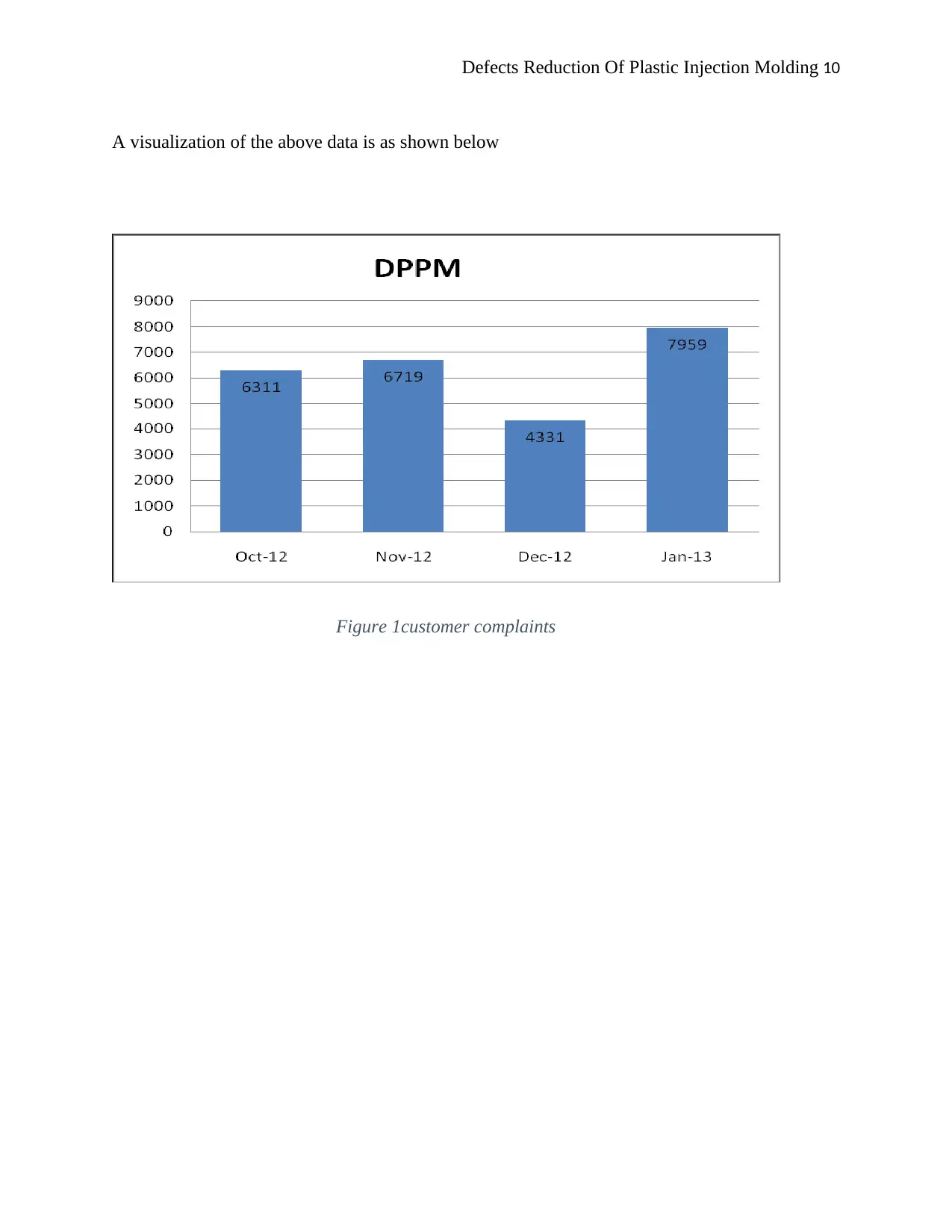
Defects Reduction Of Plastic Injection Molding 10
A visualization of the above data is as shown below
Figure 1customer complaints
A visualization of the above data is as shown below
Figure 1customer complaints
Secure Best Marks with AI Grader
Need help grading? Try our AI Grader for instant feedback on your assignments.
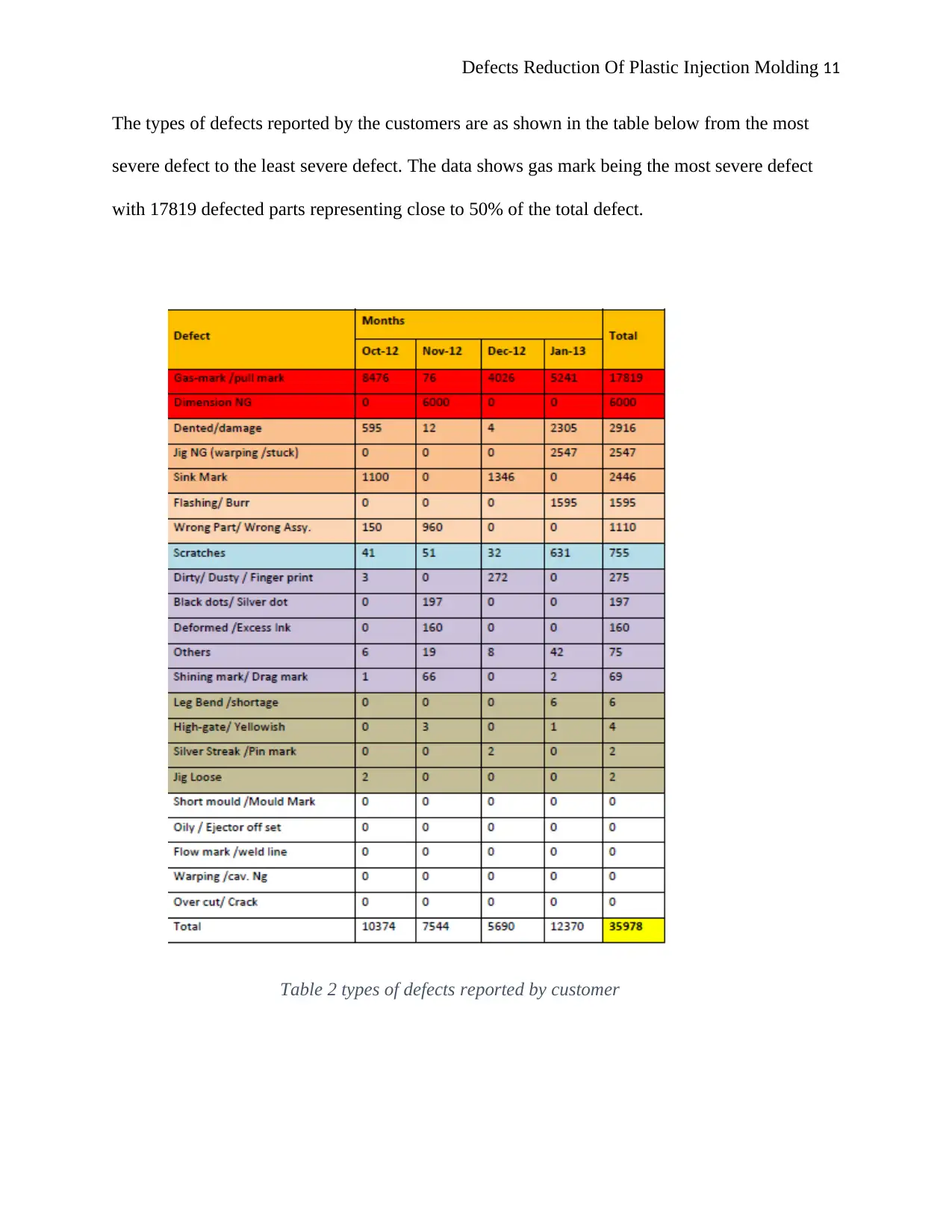
Defects Reduction Of Plastic Injection Molding 11
The types of defects reported by the customers are as shown in the table below from the most
severe defect to the least severe defect. The data shows gas mark being the most severe defect
with 17819 defected parts representing close to 50% of the total defect.
Table 2 types of defects reported by customer
The types of defects reported by the customers are as shown in the table below from the most
severe defect to the least severe defect. The data shows gas mark being the most severe defect
with 17819 defected parts representing close to 50% of the total defect.
Table 2 types of defects reported by customer
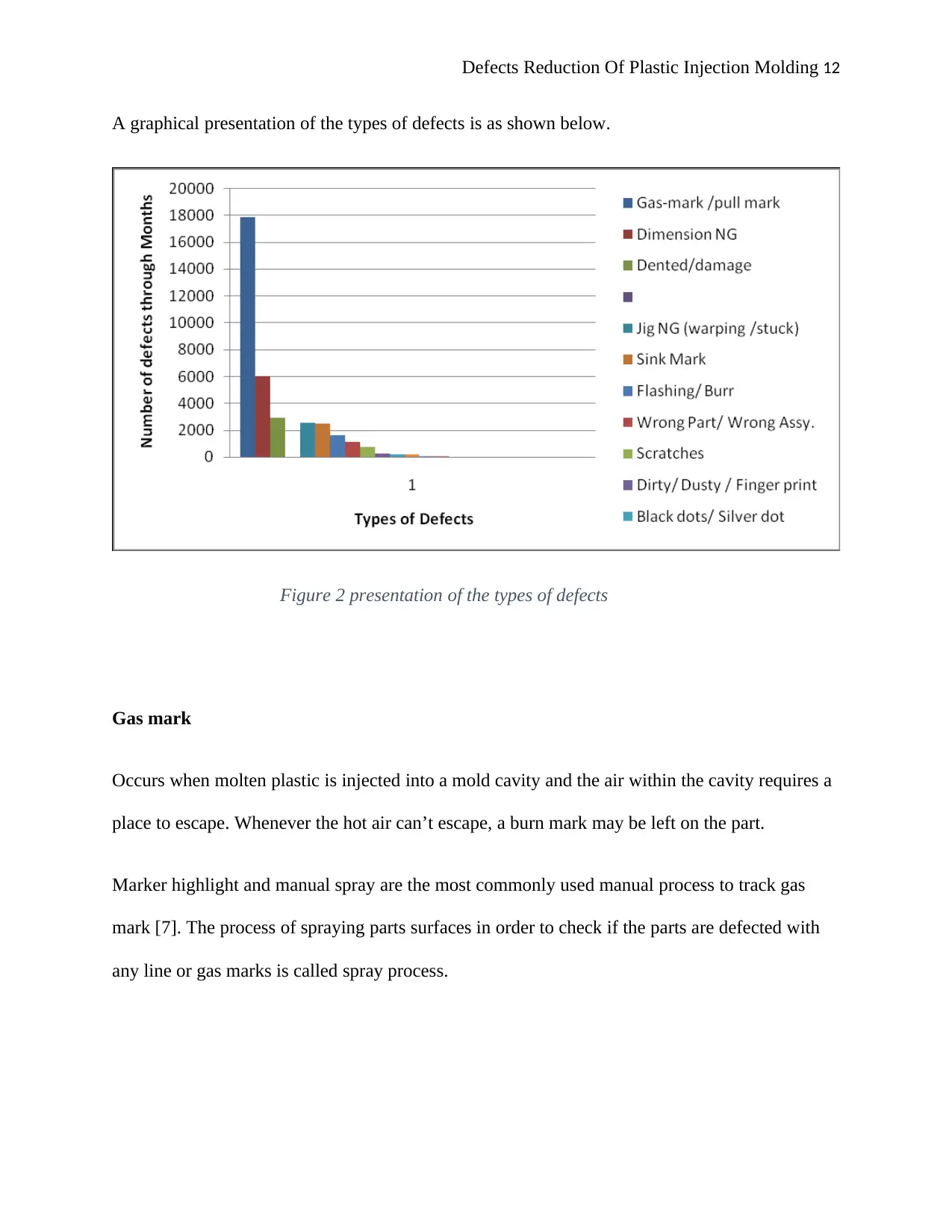
Defects Reduction Of Plastic Injection Molding 12
A graphical presentation of the types of defects is as shown below.
Figure 2 presentation of the types of defects
Gas mark
Occurs when molten plastic is injected into a mold cavity and the air within the cavity requires a
place to escape. Whenever the hot air can’t escape, a burn mark may be left on the part.
Marker highlight and manual spray are the most commonly used manual process to track gas
mark [7]. The process of spraying parts surfaces in order to check if the parts are defected with
any line or gas marks is called spray process.
A graphical presentation of the types of defects is as shown below.
Figure 2 presentation of the types of defects
Gas mark
Occurs when molten plastic is injected into a mold cavity and the air within the cavity requires a
place to escape. Whenever the hot air can’t escape, a burn mark may be left on the part.
Marker highlight and manual spray are the most commonly used manual process to track gas
mark [7]. The process of spraying parts surfaces in order to check if the parts are defected with
any line or gas marks is called spray process.
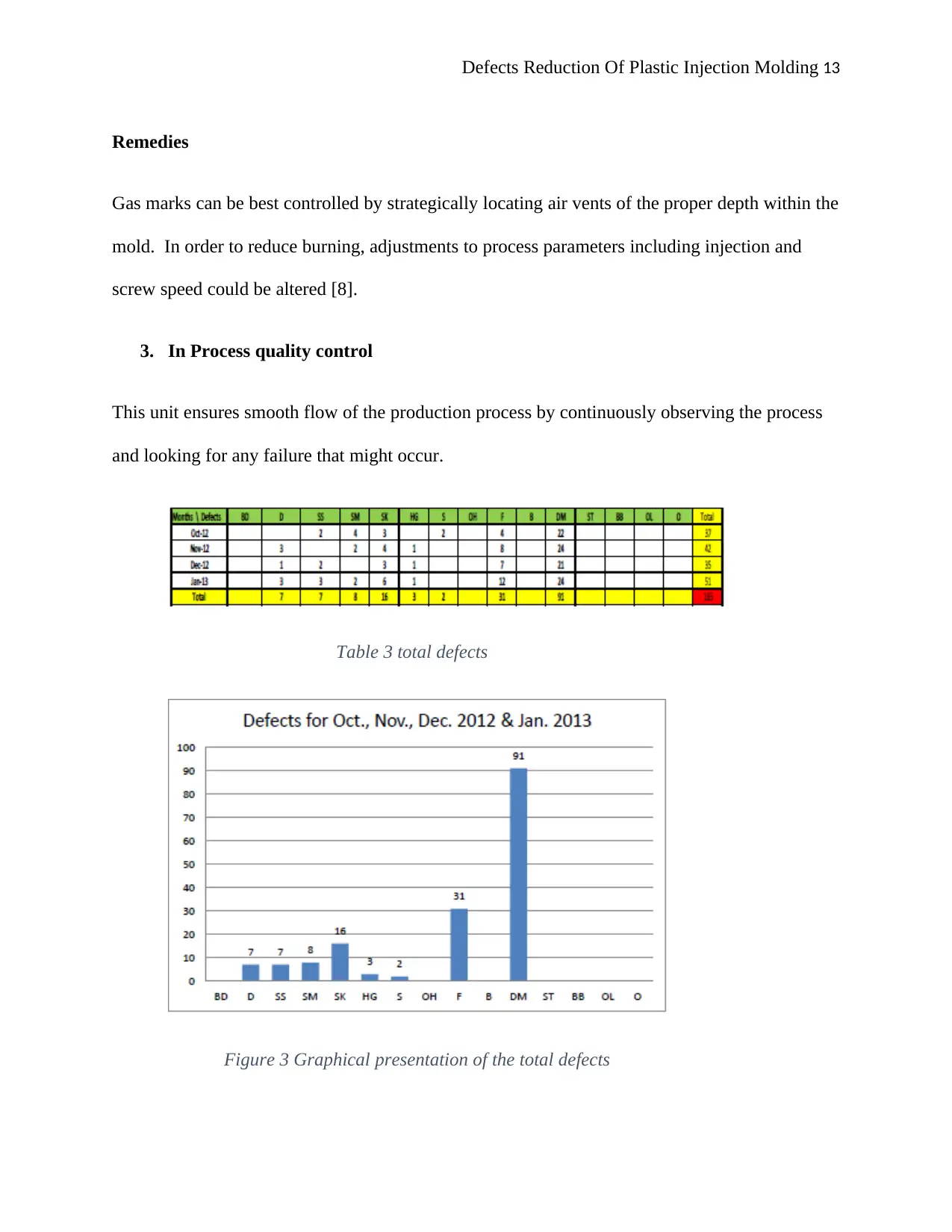
Defects Reduction Of Plastic Injection Molding 13
Remedies
Gas marks can be best controlled by strategically locating air vents of the proper depth within the
mold. In order to reduce burning, adjustments to process parameters including injection and
screw speed could be altered [8].
3. In Process quality control
This unit ensures smooth flow of the production process by continuously observing the process
and looking for any failure that might occur.
Table 3 total defects
Figure 3 Graphical presentation of the total defects
Remedies
Gas marks can be best controlled by strategically locating air vents of the proper depth within the
mold. In order to reduce burning, adjustments to process parameters including injection and
screw speed could be altered [8].
3. In Process quality control
This unit ensures smooth flow of the production process by continuously observing the process
and looking for any failure that might occur.
Table 3 total defects
Figure 3 Graphical presentation of the total defects
Paraphrase This Document
Need a fresh take? Get an instant paraphrase of this document with our AI Paraphraser

Defects Reduction Of Plastic Injection Molding 14
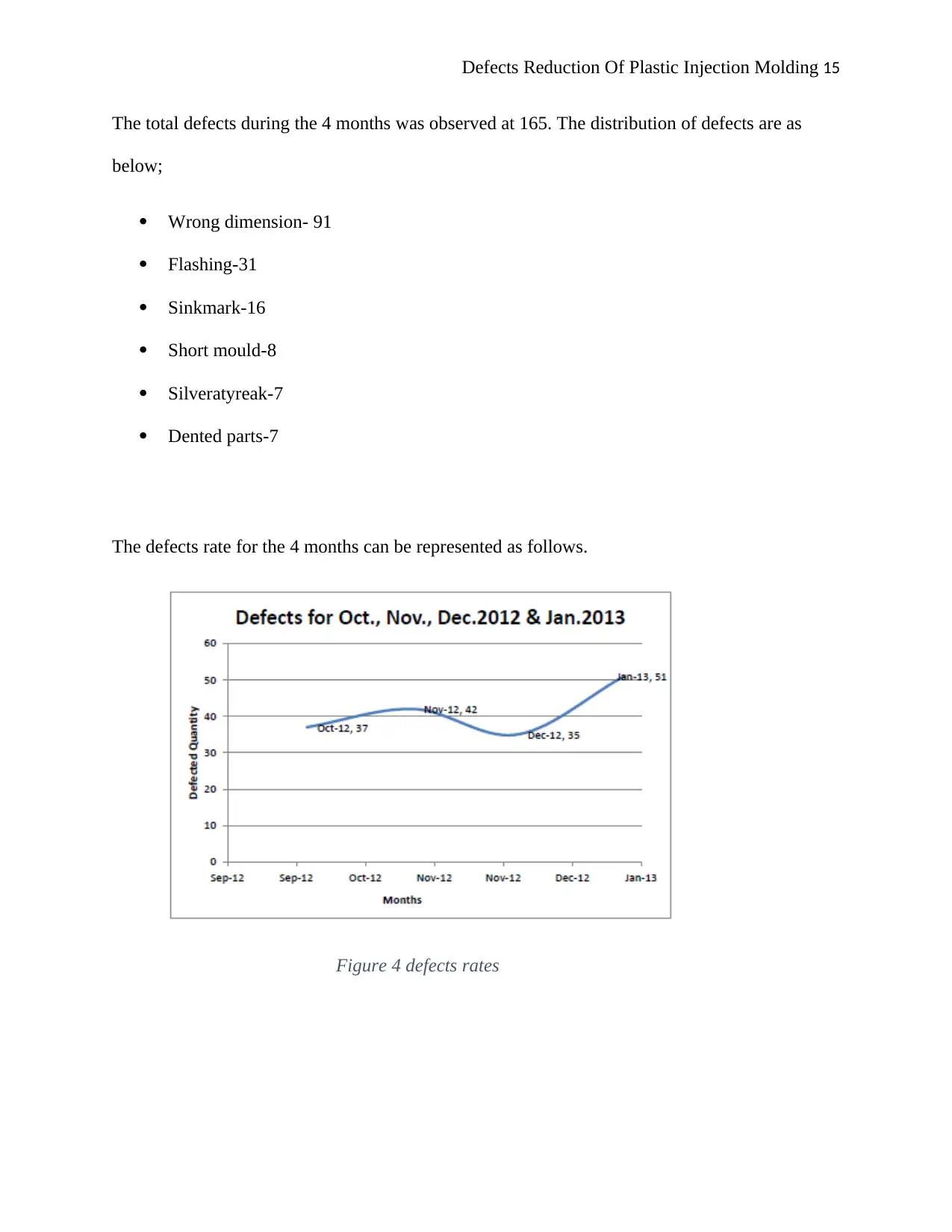
Defects Reduction Of Plastic Injection Molding 15
The total defects during the 4 months was observed at 165. The distribution of defects are as
below;
Wrong dimension- 91
Flashing-31
Sinkmark-16
Short mould-8
Silveratyreak-7
Dented parts-7
The defects rate for the 4 months can be represented as follows.
Figure 4 defects rates
The total defects during the 4 months was observed at 165. The distribution of defects are as
below;
Wrong dimension- 91
Flashing-31
Sinkmark-16
Short mould-8
Silveratyreak-7
Dented parts-7
The defects rate for the 4 months can be represented as follows.
Figure 4 defects rates
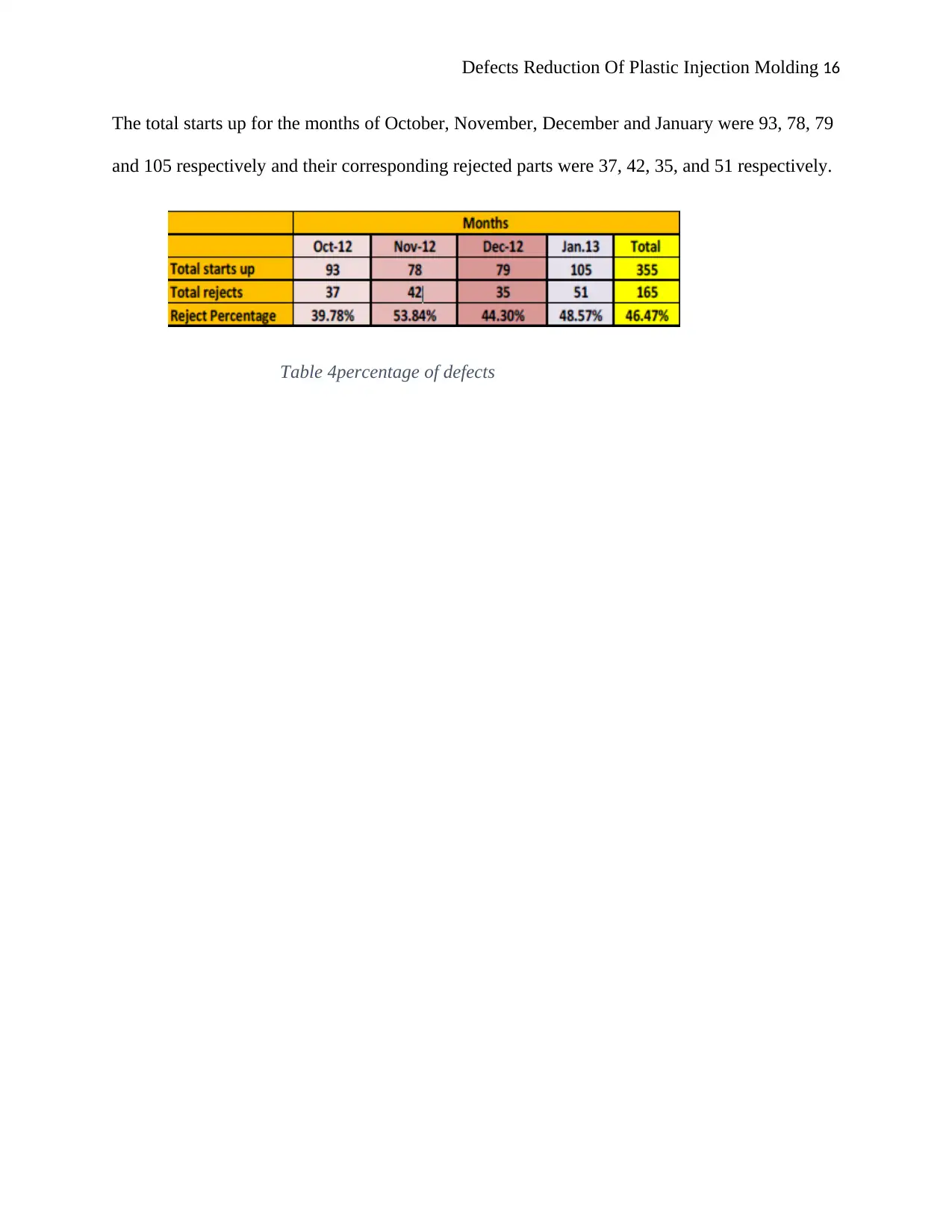
Defects Reduction Of Plastic Injection Molding 16
The total starts up for the months of October, November, December and January were 93, 78, 79
and 105 respectively and their corresponding rejected parts were 37, 42, 35, and 51 respectively.
Table 4percentage of defects
The total starts up for the months of October, November, December and January were 93, 78, 79
and 105 respectively and their corresponding rejected parts were 37, 42, 35, and 51 respectively.
Table 4percentage of defects
Secure Best Marks with AI Grader
Need help grading? Try our AI Grader for instant feedback on your assignments.
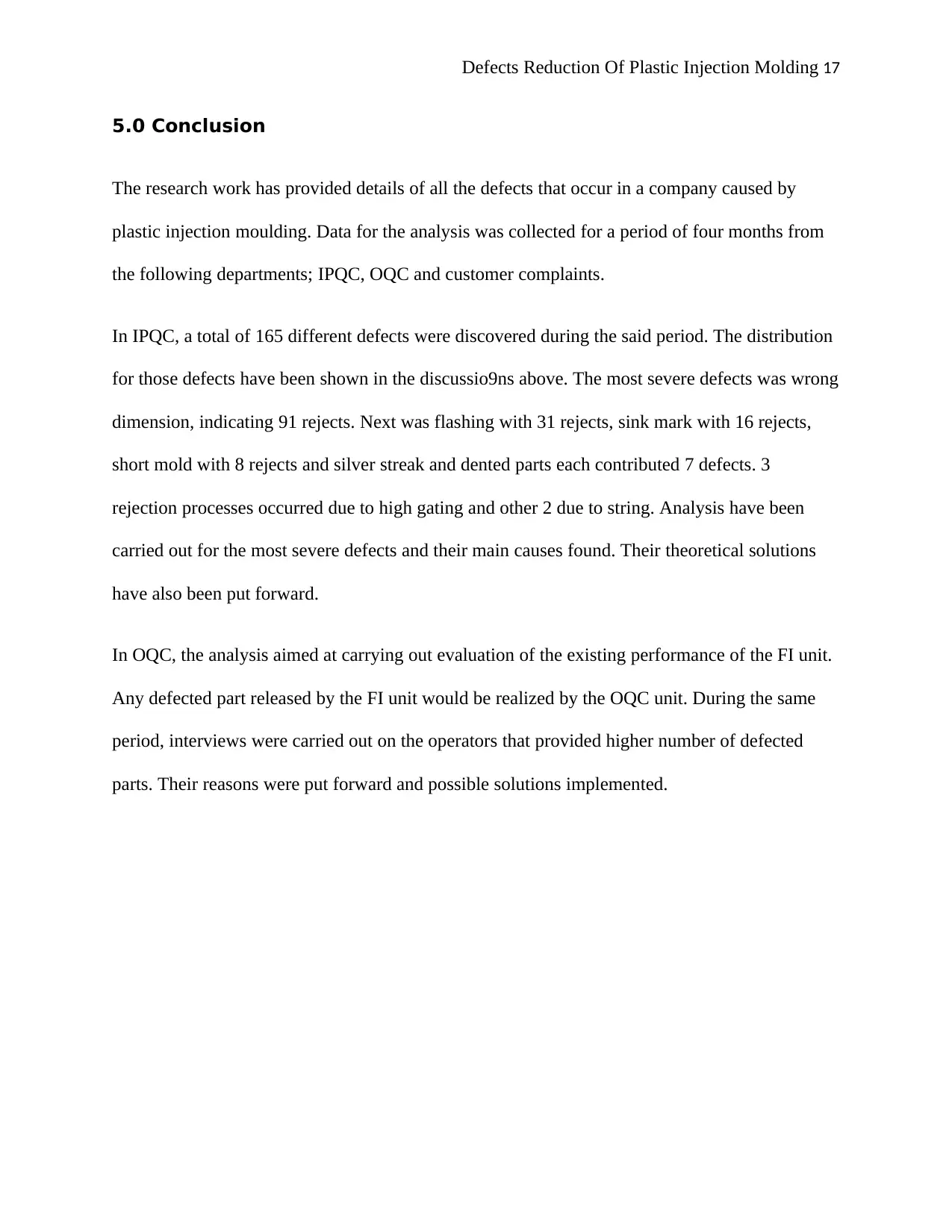
Defects Reduction Of Plastic Injection Molding 17
5.0 Conclusion
The research work has provided details of all the defects that occur in a company caused by
plastic injection moulding. Data for the analysis was collected for a period of four months from
the following departments; IPQC, OQC and customer complaints.
In IPQC, a total of 165 different defects were discovered during the said period. The distribution
for those defects have been shown in the discussio9ns above. The most severe defects was wrong
dimension, indicating 91 rejects. Next was flashing with 31 rejects, sink mark with 16 rejects,
short mold with 8 rejects and silver streak and dented parts each contributed 7 defects. 3
rejection processes occurred due to high gating and other 2 due to string. Analysis have been
carried out for the most severe defects and their main causes found. Their theoretical solutions
have also been put forward.
In OQC, the analysis aimed at carrying out evaluation of the existing performance of the FI unit.
Any defected part released by the FI unit would be realized by the OQC unit. During the same
period, interviews were carried out on the operators that provided higher number of defected
parts. Their reasons were put forward and possible solutions implemented.
5.0 Conclusion
The research work has provided details of all the defects that occur in a company caused by
plastic injection moulding. Data for the analysis was collected for a period of four months from
the following departments; IPQC, OQC and customer complaints.
In IPQC, a total of 165 different defects were discovered during the said period. The distribution
for those defects have been shown in the discussio9ns above. The most severe defects was wrong
dimension, indicating 91 rejects. Next was flashing with 31 rejects, sink mark with 16 rejects,
short mold with 8 rejects and silver streak and dented parts each contributed 7 defects. 3
rejection processes occurred due to high gating and other 2 due to string. Analysis have been
carried out for the most severe defects and their main causes found. Their theoretical solutions
have also been put forward.
In OQC, the analysis aimed at carrying out evaluation of the existing performance of the FI unit.
Any defected part released by the FI unit would be realized by the OQC unit. During the same
period, interviews were carried out on the operators that provided higher number of defected
parts. Their reasons were put forward and possible solutions implemented.
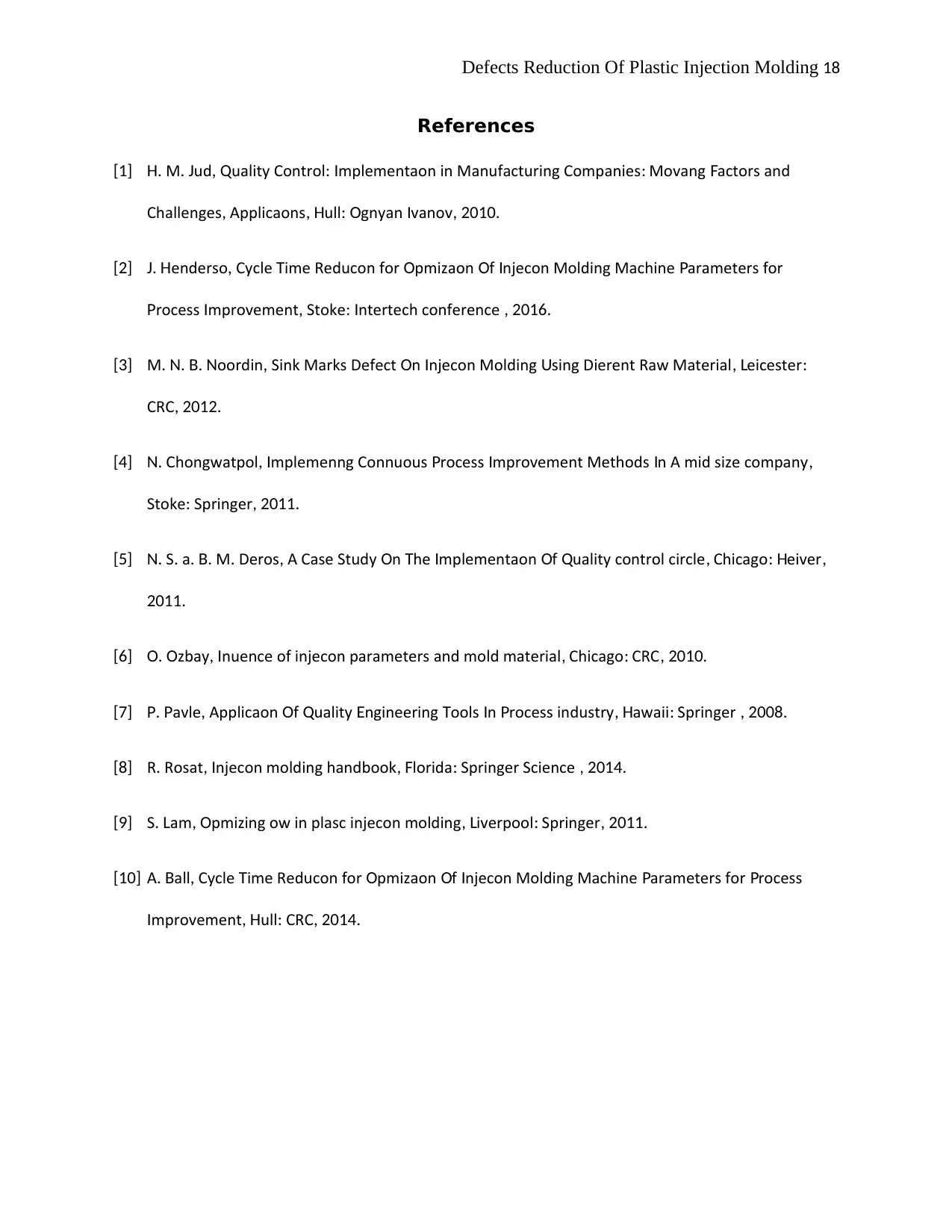
Defects Reduction Of Plastic Injection Molding 18
References
[1] M ud uality Control mplementation in Manufacturing Companies Motivating actors andH. . J , Q : I : F
Challenges Applications ull gnyan vanov, , H : O I , 2010.
[2] enderso Cycle ime Reduction for ptimization f njection Molding Machine arameters forJ. H , T O O I P
rocess mprovement Stoke ntertech conferenceP I , : I , 2016.
[3] M oordin Sink Marks Defect n njection Molding sing Different Raw Material eicester. N. B. N , O I U , L :
CRC, 2012.
[4] Chongwatpol mplementing Continuous rocess mprovement Methods n A mid size companyN. , I P I I ,
Stoke Springer: , 2011.
[5] S a M Deros A Case Study n he mplementation f uality control circle Chicago eiverN. . . B. . , O T I O Q , : H ,
2011.
[6] zbay nfluence of injection parameters and mold material Chicago CRCO. O , I , : , 2010.
[7] avleti Application f uality ngineering ools n rocess industry awaii SpringerP. P , O Q E T I P , H : , 2008.
[8] R Rosat njection molding handbook lorida Springer Science. , I , F : , 2014.
[9] S am ptimizing fl ow in plastic injection molding iverpool Springer. L , O , L : , 2011.
[10] A all Cycle ime Reduction for ptimization f njection Molding Machine arameters for rocess. B , T O O I P P
mprovement ull CRCI , H : , 2014.
References
[1] M ud uality Control mplementation in Manufacturing Companies Motivating actors andH. . J , Q : I : F
Challenges Applications ull gnyan vanov, , H : O I , 2010.
[2] enderso Cycle ime Reduction for ptimization f njection Molding Machine arameters forJ. H , T O O I P
rocess mprovement Stoke ntertech conferenceP I , : I , 2016.
[3] M oordin Sink Marks Defect n njection Molding sing Different Raw Material eicester. N. B. N , O I U , L :
CRC, 2012.
[4] Chongwatpol mplementing Continuous rocess mprovement Methods n A mid size companyN. , I P I I ,
Stoke Springer: , 2011.
[5] S a M Deros A Case Study n he mplementation f uality control circle Chicago eiverN. . . B. . , O T I O Q , : H ,
2011.
[6] zbay nfluence of injection parameters and mold material Chicago CRCO. O , I , : , 2010.
[7] avleti Application f uality ngineering ools n rocess industry awaii SpringerP. P , O Q E T I P , H : , 2008.
[8] R Rosat njection molding handbook lorida Springer Science. , I , F : , 2014.
[9] S am ptimizing fl ow in plastic injection molding iverpool Springer. L , O , L : , 2011.
[10] A all Cycle ime Reduction for ptimization f njection Molding Machine arameters for rocess. B , T O O I P P
mprovement ull CRCI , H : , 2014.
1 out of 18
Related Documents
Your All-in-One AI-Powered Toolkit for Academic Success.
+13062052269
info@desklib.com
Available 24*7 on WhatsApp / Email
![[object Object]](/_next/static/media/star-bottom.7253800d.svg)
Unlock your academic potential
© 2024 | Zucol Services PVT LTD | All rights reserved.




![[SOLVED] Preparing Continuous Improvement Plan for GSK](/_next/image/?url=https%3A%2F%2Fdesklib.com%2Fmedia%2Fimages%2Fbj%2Ff9dcf7854c6240c7ae29a76868ad0efc.jpg&w=256&q=75)
